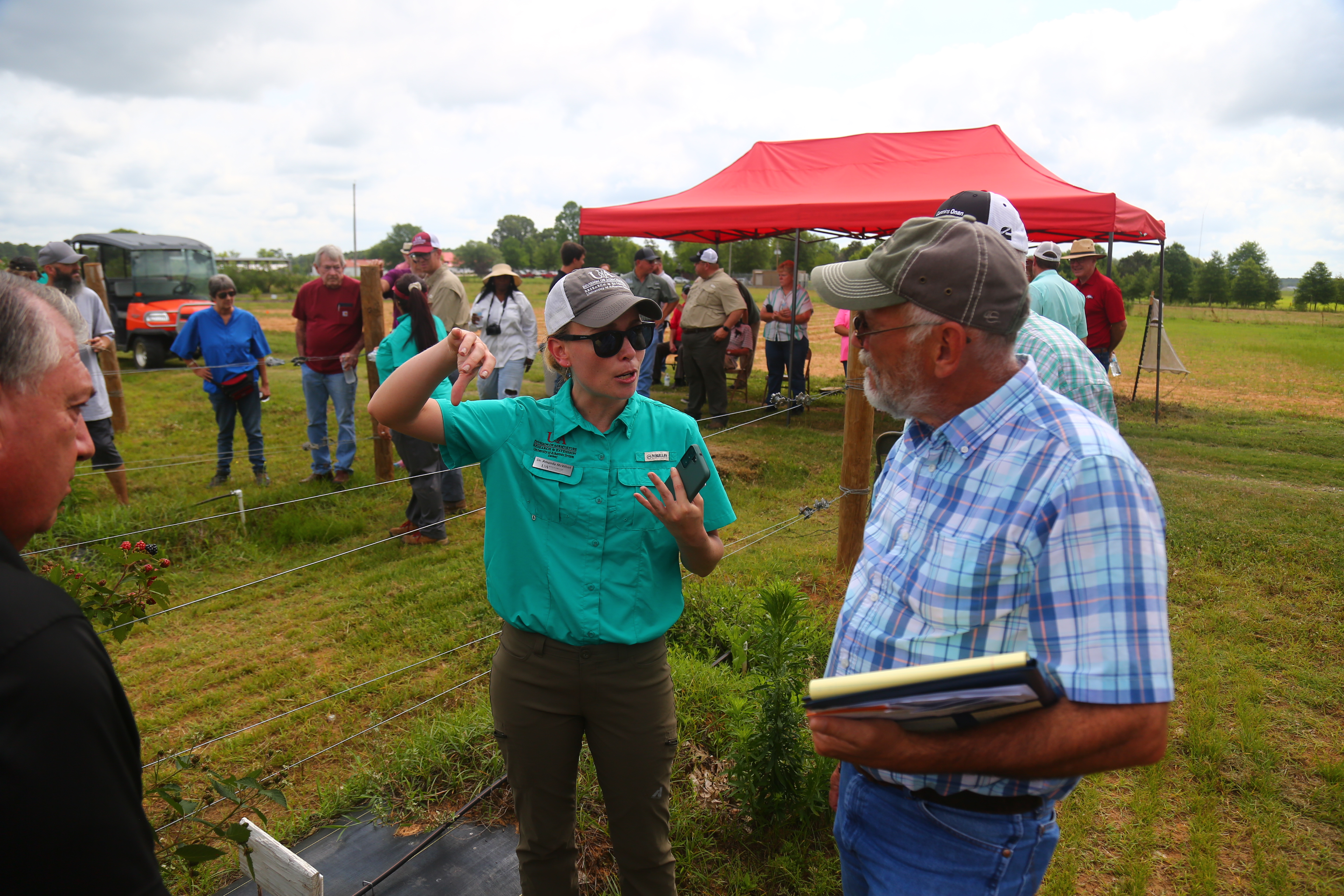June 10, 2022
Horticulture field day — live — returns after two-year hiatus
By Ryan McGeeney
U of A System Division of Agriculture
Fast Facts:
- First in-person horticulture field day in two years
- Emphasis on blackberry research
(781 words)
Newsrooms: With additional art at https://flic.kr/s/aHBqjzTvVx)
HOPE, Ark. — It had been a long, lonely summer or two since the Southwest Research and Extension Center had hosted its premier event, the annual Horticulture Field Day, “live and in-person.” On June 7, however, the doors were open — and growers and agents alike were glad to be back.
Daniel Rivera, associate professor and SWREC director for the University of Arkansas System Division of Agriculture, said his staff had been looking forward to the in-person event since he accepted the directorship in 2021.
“When I got here, this field day was one of the main things the staff talked about,” Rivera said. “They view it as a point of pride — something they’re really proud of, something they feel ownership of.”
The initial wave of the COVID-19 pandemic had forced the University of Arkansas System Division of Agriculture, along with many other public entities, to go mostly — almost entirely — “virtual,” streaming presentations to the interested public over Zoom and other Internet platforms. The summer of 2021, with the rise of the COVID Delta variant, wasn’t any kinder.
In October 2021, SWREC hosted its annual beef and forages field day, which was met with cautious enthusiasm. Eyes then turned toward June, and Rivera and his staff began preparations in earnest.
“We had a good turnout in the fall, and that primed the pump,” Rivera said. “The staff and agents just wanted to have this field day. They wanted to get back to a sense of normalcy.”
About 100 people attended Tuesday’s event, which focused chiefly on aspects of production and pest management of blackberries, as well as other fruits and vegetables.
Amanda McWhirt, extension fruit horticulture specialist, and Aaron Cato, extension horticulture integrated pest management specialist, both for the Division of Agriculture, spoke to attendees about common challenges and remedies in the production of blackberries, watermelon, squash and tomatoes.
“I was impressed by the interest in blackberry production in general,” McWhirt said. “And not just in backyards — people trying to do small planting, working toward commercial production. I think there’s just increasing demand as more people become interested in the health benefits of fruits and new flavors that are coming out in new cultivars from our breeding program.
“People are realizing that it’s a nice market they can dip their toe into and test it out,” she said. “There were a lot of good questions on how to set all that up and manage it well.”
Attendees also were interested in trellis types, varieties and cultural control techniques for weed control, Cato said.
“There were a lot of questions about ways to integrate cultural control techniques for insects, weeds, and diseases,” Cato said. “We were happy to be able to demonstrate these techniques and how they can be used successfully for fruit and vegetable production during the field tour.
“For instance, we had a lot of questions about using landscape fabric in blackberries,” he said. “This is a strategy that is gaining wider use in Arkansas and helps growers to reduce herbicide use, manage weed pressure and improve production.”
Staci Henderson, who produces chicken, cattle and some fruit and vegetables in Pike County, said the wealth of blackberry research drew her to the event.
“If my ground does good with the 100-foot row I planted, if things work out and I can do it properly, I’d like to go for a whole stand,” she said.
To learn about extension programs in Arkansas, contact your local Cooperative Extension Service agent or visit www.uaex.uada.edu. Follow us on Twitter and Instagram at @AR_Extension. To learn more about Division of Agriculture research, visit the Arkansas Agricultural Experiment Station website: https://aaes.uark.edu. Follow on Twitter at @ArkAgResearch. To learn more about the Division of Agriculture, visit https://uada.edu/. Follow us on Twitter at @AgInArk.
About the Division of Agriculture
The University of Arkansas System Division of Agriculture’s mission is to strengthen agriculture, communities, and families by connecting trusted research to the adoption of best practices. Through the Agricultural Experiment Station and the Cooperative Extension Service, the Division of Agriculture conducts research and extension work within the nation’s historic land grant education system.
The Division of Agriculture is one of 20 entities within the University of Arkansas System. It has offices in all 75 counties in Arkansas and faculty on five system campuses.
Pursuant to 7 CFR § 15.3, the University of Arkansas System Division of Agriculture offers all its Extension and Research programs and services (including employment) without regard to race, color, sex, national origin, religion, age, disability, marital or veteran status, genetic information, sexual preference, pregnancy or any other legally protected status, and is an equal opportunity institution.
# # #
Media Contact:
Ryan McGeeney
rmcgeeney@uada.edu
@Ryan_McG44
501-671-2120
